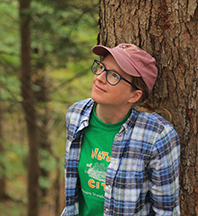Week of February 18, 2024 – February 24, 2024
by Anna Stunkel, Environmental Educator
The recent weather has been uncharacteristically sunny here in Central New York (not to mention warm!), helping to lift our spirits and encourage outdoor adventures. During a walk around the preserve on one of these gorgeous days, I found myself attuned to how the sunshine highlights different textures in the woods. Tiny details like leaf veins and snowflake patterns branch out to create a bigger picture of beauty. I walked slowly, pausing to appreciate and feel the tiny, soft moss fronds with haircap tendrils growing among them. With the lack of snow, wavy, gilled mushroom caps were especially visible along the walk. Yellow Birch bark is covered in webs of moss, rough patches, and horizontal markings called lenticels. These structures essentially allow the tree to “breathe” by exchanging gas with the surrounding air.
One of my favorite activities to help others appreciate tree bark texture is called “meet a tree.” In this game, participants are blindfolded or close their eyes and are led to a tree by another person. They can feel the tree’s bark, but can’t look at it. Then, they’re led back to the starting point and must try to find the tree by feel. When we focus on just one of our senses, such as touch, the things that we notice with that sense become more focused since there is less “background noise” to distract us.
There are many ways that we humans can tune into observing and interacting with nature’s textures, such as by drawing a feather’s barbs with colored pencils, sculpting a pinecone from clay, or repurposing invasive plants by weaving them into baskets (like program participants did this past Friday). Hands-on activities like these deepen our connection to nature and sharpen our observation skills. How have you been appreciating the textures of nature around you lately?


